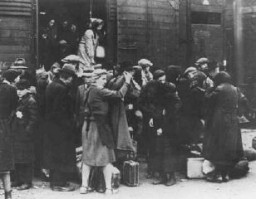You searched for: 余额宝理财系统搭建【TG���������@EK7676】平台包网搭建余额宝理财系统搭建【TG���������@EK7676】平台包网搭建1tVO4utgRM
<< Previous | Displaying results 201-225 of 653 for "余额宝理财系统搭建【TG���������@EK7676】平台包网搭建余额宝理财系统搭建【TG���������@EK7676】平台包网搭建1tVO4utgRM" | Next >>
-
Albert Speer
PhotoDefendant Albert Speer during the International Military Tribunal trial of war criminals at Nuremberg. Germany, between November 20, 1945, and October 1, 1946.

-
Joseph Goebbels at a rally in favor of the boycott of Jewish-owned shops
PhotoJoseph Goebbels, the Nazi minister of propaganda, speaks at a rally in favor of the boycott of Jewish-owned shops. Berlin, Germany, April 1, 1933.
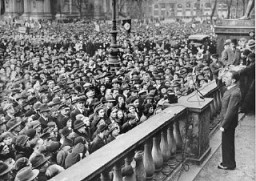
-
Members of the SA during boycott of Jewish-owned businesses
PhotoSA men in front of Jewish-owned store urge a boycott with the signs reading "Germans! Defend Yourselves! Don't buy from Jews!" Berlin, Germany, April 1, 1933.
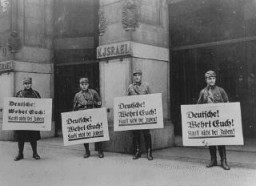
-
Anti-Jewish boycott
PhotoDuring the anti-Jewish boycott, an SA man stands outside a Jewish-owned store with a sign demanding that Germans not buy from Jews. Berlin, Germany, April 1, 1933.
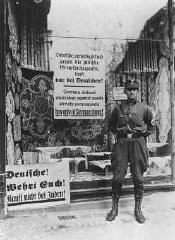
-
Crematorium in Dachau
PhotoA survivor stokes smoldering human remains in a crematorium oven that was still lit in the Dachau camp. Photograph taken upon the liberation of the camp. Dachau, Germany, April 29-May 1, 1945.
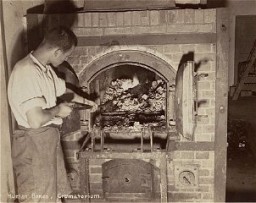
-
Anti-Jewish boycott poster in Berlin
PhotoA boycott sign posted on the display window of a Jewish-owned business reads: "Germans defend yourselves against Jewish atrocity propaganda. Buy only at German shops!" Berlin, Germany, April 1, 1933.

-
SS Lieutenant Colonel Arthur Roedl
PhotoSS Lieutenant Colonel Arthur Roedl, commandant of the Gross-Rosen concentration camp. Gross-Rosen, Germany, between May 1, 1941, and September 15, 1942.
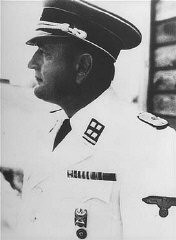
-
Investigating German atrocities
PhotoMembers of a US congressional committee investigating German atrocities view the emaciated body of a dead prisoner at the Dora-Mittelbau concentration camp, near Nordhausen. Germany, May 1, 1945.
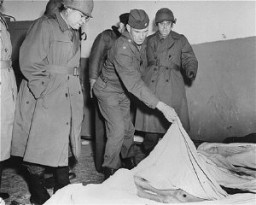
-
Training in farming skills
PhotoJewish youth attend a class on transplanting seedlings, part of a general course in farming sponsored by the American Jewish Joint Distribution Committee at the Bergen-Belsen displaced persons camp. Germany, August 1, 1946.
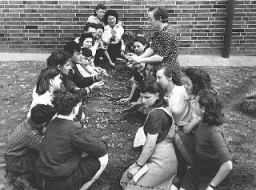
-
Tehran Conference
PhotoSoviet leader Joseph Stalin (left), US president Franklin D. Roosevelt (center), and British prime minister Winston S. Churchill (right) at the Tehran Conference. Tehran, Iran, between November 28 and December 1, 1943.
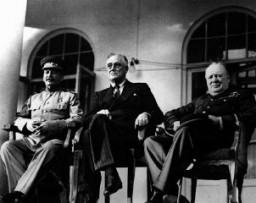
-
Boycott sign
PhotoScene during the boycott of Jewish businesses. A sign on truck carrying Storm Troopers (SA) urges "Germans! Defend yourselves. Don't buy from Jews." Berlin, Germany, April 1, 1933.

-
A mother and daughter living in a container
PhotoA mother checks on her sick daughter inside the container where they live in an internally displaced persons (IDP) camp near Erbil, Iraqi Kurdistan. September 1, 2015.
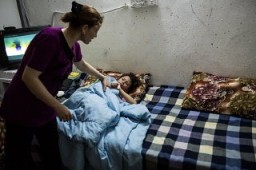
-
Soviet prisoners of war under German guard
PhotoAt left, a column of Soviet prisoners of war, under German guard, marches away from the front. Place uncertain, July 1, 1941.
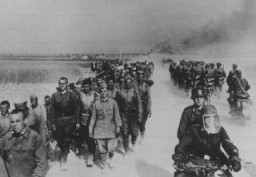
-
Press reports of the sentences handed down by the International Military Tribunal
PhotoPeople gather in the street to read a special edition of the Nurnberger newspaper reporting the sentences handed down by the International Military Tribunal. Nuremberg, Germany, October 1, 1946.

-
Looking through the belongings of massacred Jews
PhotoSoldiers from unidentified units of Einsatzgruppe C look through the possessions of Jews massacred at Babi Yar, a ravine near Kiev. Soviet Union, September 29–October 1, 1941.
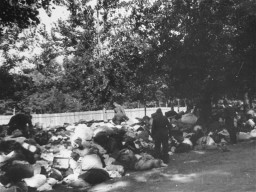
-
1946–1948: Key Dates
ArticleExplore a timeline of key events during 1946-1948. Learn about the aftermath of the Holocaust and the obstacles survivors faced.

-
SS officers and German nurses
PhotoSS officers and German nurses gather during the dedication ceremony of the new SS hospital in Auschwitz, September 1, 1944. Among those pictured are Karl Höcker, Josef Kramer, and SS-Hauptsturmführer Heinrich Schwarz.
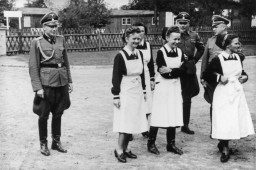
-
Crowd in Berlin during the anti-Jewish boycott
PhotoGermans in front of a Jewish-owned department store in Berlin during the anti-Jewish boycott. Berlin, Germany, April 1, 1933.
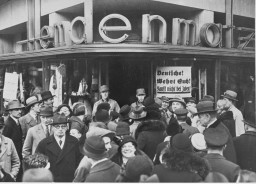
-
Mittelbau Main Camp: In Depth
ArticleLearn about conditions and forced labor in Dora-Mittelbau, the center of an extensive network of forced-labor camps for the production of V-2 missiles and other weapons.
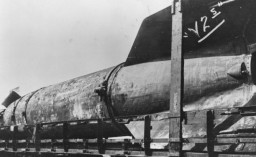
-
Freiberg
ArticleLearn about the Freiburg subcamp of Flossenbürg, including its establishment, prisoner population, and conditions there.
-
1942: Key Dates
ArticleExplore a timeline of key events during 1942 in the history of Nazi Germany, World War II, and the Holocaust.
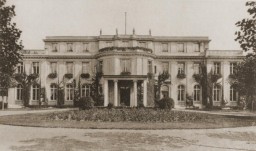
-
Berga-Elster ("Schwalbe V")
ArticleAt the Berga-Elster subcamp of Buchenwald, prisoners were forced to do dangerous and brutal work in tunnels to support fuel production for the German war effort.
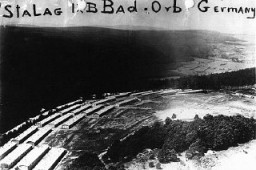
-
Auschwitz: Key Dates
ArticleExplore a timeline of key events in the history of the Auschwitz camp complex in German-occupied Poland.
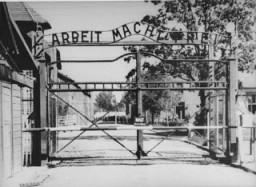
-
Fürstengrube
ArticleLearn about Fürstengrube subcamp of Auschwitz, including its establishment, administration, prisoner population, and forced labor and conditions in the camp.
-
1944: Key Dates
ArticleExplore a timeline of key events during 1944 in the history of Nazi Germany, World War II, and the Holocaust.
